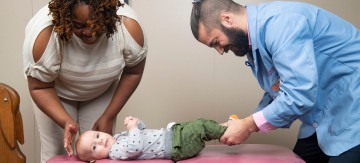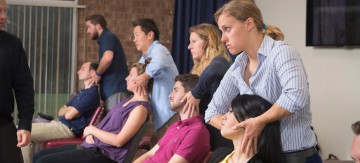[et_pb_section bb_built=”1″][et_pb_row][et_pb_column type=”4_4″][et_pb_text]

Students familiar with the philosophy and science of chiropractic already know that chiropractic care provides preventative, natural and holistic care to help keep the body at optimal health. And, when it comes to developing healthy habits, it’s never too early to start! That’s why more and more parents are introducing their children to chiropractic. They’ve seen the benefits of chiropractic for themselves and want their kids to receive the many benefits chiropractic care has to offer. But what are the differences between adjusting a child compared to an adult, and how can chiropractic students prepare for this rewarding career path after graduation?
Dr. Ron Castellucci, an internationally recognized expert in pediatric analysis and adjusting, explains.
Why do Kids Need Chiropractic?
Parents unfamiliar with the benefits of chiropractic often ask this question. They think that because children don’t suffer from back pain, they won’t benefit from chiropractic as much as adults. But, as Dr. Castellucci explains, that’s just not the case. “It is important for parents to know that from the time children are born, they have many opportunities to get a subluxation.” That’s because even small bumps and falls from learning to walk or riding a bike can cause subluxations, which are misalignments between the bones (vertebrae) of the spine which can disrupt proper nerve function and lead to decreased performance and overall health. Even birth can cause subluxation. “Being born is stressful on the spine,” Dr. Castellucci explains, “and it is during the normal process of birth that children often get their first subluxations.” Fortunately, regular chiropractic care can help young spines grow up healthy. “When a newborn is adjusted and then checked regularly for subluxation, the spine grows healthy and their nervous system develops without the damaging interference caused by years of subluxation.”
The Differences Between Child and Adult Spines
While the spines of children and adults are in many ways very similar, there are still some key differences between adjusting a child and adjusting an adult. “A child has more flexibility,” explains Dr. Castellucci, “which is due to the immaturity of the muscles, ligaments, and joints; and, of course, the structures are much smaller.” As a result, pediatric chiropractors “must be very specific and use much less force, adapting their adjustments according to the age and size of the child.” Pediatric chiropractors also need to face some unique challenges in their line of work. “A child is also very wiggly,” warns Dr. Castellucci, “so while this makes for a fun visit, it can be challenging for the inexperienced chiropractor.”
But with the right chiropractic training, he assures, chiropractic students can soon develop the hands-on skills they need to start their career in pediatric chiropractic.
Adjusting Techniques to Learn During Your Chiropractic Training
As students complete their chiropractic education, they learn how to adapt adjustments to the age of their patient. “The child who is hours old will be adjusted with techniques adapted for their age just like a patient who is 90 will be adjusted with appropriate techniques,” says Dr. Castellucci, emphasizing that “the key here is the chiropractor must have training to care for children.” To prepare for this rewarding career path, Dr. Castellucci advises students to “be sure to take pediatric adjusting and analysis courses in chiropractic college,” and to “consider becoming certified by taking the International Chiropractic Pediatric Association certification program.”
With that specialized training and a chiropractic degree from a top school of chiropractic, students will be well prepared to start their career in pediatric chiropractic after graduation.
[/et_pb_text][/et_pb_column][/et_pb_row][/et_pb_section]








